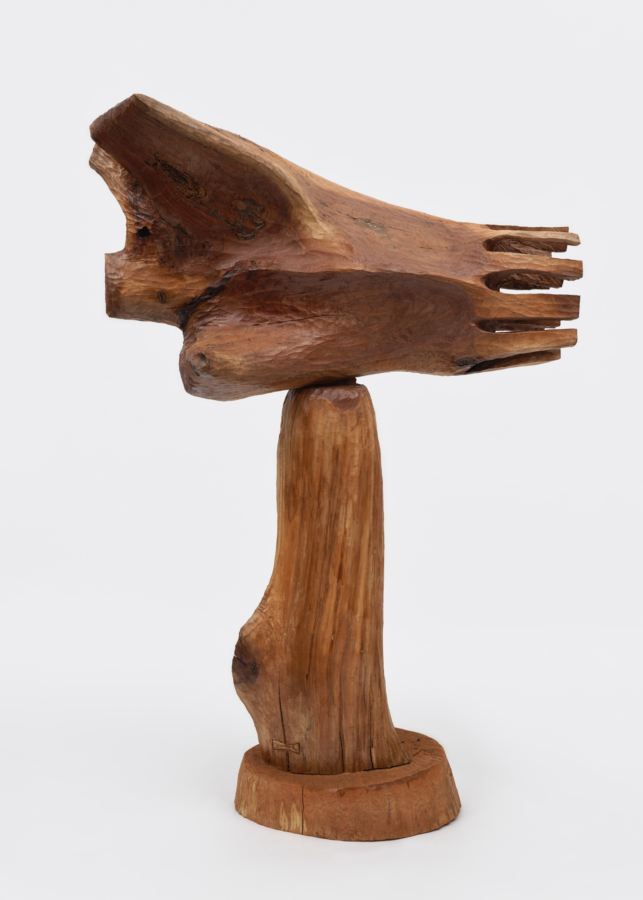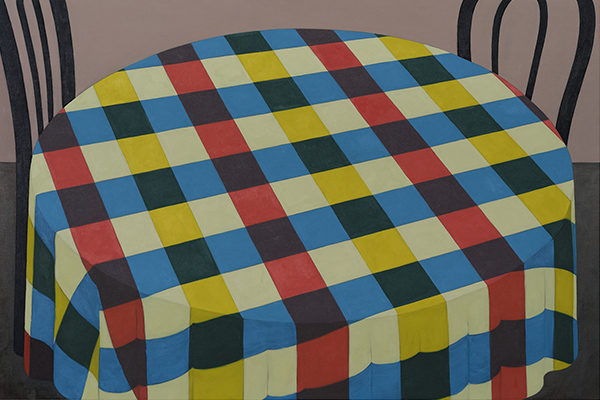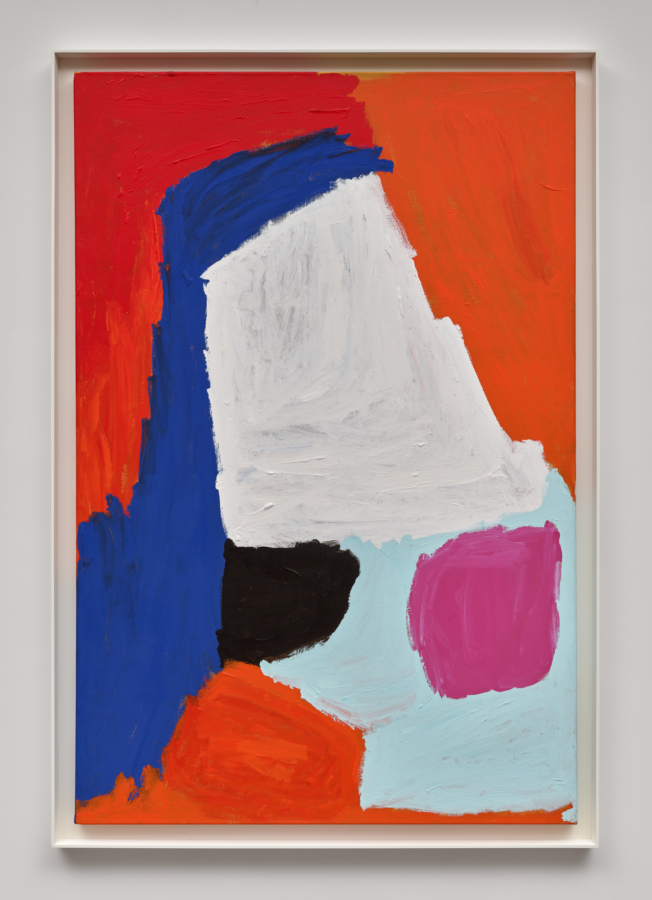2024
Maja Ruznic: Gouaches, Karma Books, New York, 2024
It was her voice that made
The sky acutest at its vanishing.
She measured to the hour its solitude.
She was the single artificer of the world
In which she sang. And when she sang, the sea,
Whatever self it had, became the self
That was her song, for she was the maker. Then we,
As we beheld her striding there alone,
Knew that there never was a world for her
Except the one she sang and, singing, made.
—Wallace Stevens, excerpt from “The Idea of Order at Key West,” 1923
Though suffused with shadow, Maja Ruznic’s gouaches are pierced by a subterranean light. Diary-page sized, and layered on thick, irregular, handmade paper, they are much smaller than her typically enormous oil paintings and far more intimate. Ruznic has likened them to portals, without which she could not create her large-scale work. Yet preparatory as they may be, they emerge from a different part of the artist’s psyche and deliver us to distinct realms of our own.
Ruznic’s gouaches stem from the part of the artist’s subconscious that feels suffused with “little secrets, spells, and recipes.”1 Yet if they are recipes for her larger works, then they are also sumptuously prepared feasts. Merging figurative elements with abstract and geometrical shapes, they beckon us to follow them towards the underworlds they intimate. Gardens of the imagination bloom in these alternate topoi, which are not nearly as hellish as the paintings of Hieronymus Bosch nor as innocently efflorescent as Eden. Rather, like some midsummer night’s dream, Ruznic’s nocturnal arcadias germinate fantastical alter egos and shadow selves. In many of them, grids, webs, patterns, and layers of floating shapes bar our entrance, even after their seductive surfaces have beckoned.
In When Sleep Never Comes (2022), a purplish-black, palm tree–like form is barely distinguishable from the tenebrous background out of which it blooms like a potted psalm. The image is so matte and darkly pigmented that its surface conjures velvet. Against such lush darkness, the smoldering fires of red that peek through sear our eyes. The artist has compared the creation of these works on paper to the “making of little moth paintings” and their pigmented surfaces to “powdery wings.” Like moths, Ruznic’s 9 images strain towards the light. Foregoing self-annihilation, however, they close in on themselves, guarding their secrets.
As in the infinite regress of one’s own reflection in the mirror, Ruznic’s works on paper manifest an astonishingly vast capacity for self-extension despite their diminutive scale. These paintings seem to project obscured aspects of the artist’s psyche, which are further enshrouded by their breathy surfaces. The boundaries between surface and depth dissolve, just as one’s own reflection deliquesces in a cloud of steam. No wonder their imagery hails from the depths: Ruznic has been making works on paper since her origins as a painter. As a Bosnian child in flight from war in a post-Yugoslavian refugee camp, Ruznic was miraculously gifted with a set of watercolors and paper by her mother. To this day, the artist cannot comprehend how she was able to procure them, or the sacrifices her single mother made to protect her child. Works on paper are not ancillary to Ruznic’s practice; they are primordial.
Yet while the artist’s gouaches may be portals to her unconscious, and the traumas that inhere within, their ornate gates and otherworldly gatekeepers foreclose their conquest. Like the upside-down canoe that shapes the forehead of the starryeyed seer in Curious Guy (2022), these mystical figures transport us along rivers of pigment to an underworld that exists beyond representation. In the end, there are no people from our earthly realm in Ruznic’s images, just uncanny collections of shapes and colors.
Despite the preponderance of wild gods and other magical figures in her work, Ruznic is an abstract painter at heart. Pigments rather than personages inspire her juxtapositions. Her motivations are aesthetic, rather than narrative. As is manifest in her vocabulary of forms, Ruznic’s abstractions dialogue with many of the great shapeshifters in the Western tradition, including Hilma af Klint, Paul Klee, Piet Mondrian, Odilon Redon, Helen Frankenthaler, and Richard Diebenkorn, to name but a few. In this way, her paintings seem to harken back not only in space, but also in time. Although her forms cite the modern, their inspirations are as timeless as the rock carvings inscribed in the southwestern landscape surrounding her New Mexico studio. Alongside what Wallace Stevens describes as “an idea of order” in Ruznic’s geometric compositions, there is a spirit that defies definition.
In Stevens’s poem, “The Idea of Order at Key West,” a lone, mysterious singer strides along a shore, emitting sounds that evoke the “grinding water and gasping wind.” Her bewitched listeners struggle to understand the origin and meanings of the intonations they hear. “Whose spirit is this?” they wonder, eventually concluding that hers is “not only the dark voice of the sea,” but that this songstress is herself the creator of the world it thrums, by channeling the elemental forces surrounding her. The same might be said of the painter, through whose “dimly starred” portals, traces of “ourselves and our origins” emerge in “ghostlier demarcations.”
Gazing at Ruznic’s paintings, I feel the song. In some of her images, I also see the singer. There she is in The Woman Who Waits at the Edge of Anger (2022), the “single artificer of the world” making her way through a “sunken coral water-walled” cloud. Although rendered in the same erubescent hues as the background that bleeds her, her figure cuts a form from formlessness. Channeling the deep voice of the sea even in this mute image, the artist thus makes a world that is as richly redmagenta- blue-gold as she is. Incantation, incarnate, incarnadine: one cannot help but feel “the dark/ Encroachment of that old catastrophe” as we observe the sanguine body melting in a carmine miasma. Yet even as the boundary between figure and ground all but dissolves, the image creates its own “idea of order” in the distinction between what is seen and what is felt. Stevens’s poems, which Ruznic’s husband, the painter Joshua Hagler, has described as koans, keep returning to me as I try in vain to penetrate her gouache-stained mysteries.
Like Stevens, Ruznic wrestles with questions of divinity, which transmit through her work like the incantation that emerges from “beyond the genius of the sea.” To be clear, this is not the form of divinity that Western religions dictate: like the singer’s song, Ruznic’s paintings emerge from a body that is “wholly body” and yet through which some vaster, intangible force is activated that, in the painter’s own words, feels “dark and rich and timeless.” After all, as Stevens asks in another poem, “What is divinity if it can come/ Only in silent shadows and in dreams?” For the poet, as for the painter, “Divinity must live within herself.” Painting, like song, encounters the spirit within, and manifests it in form. For the artist, the process itself is akin to an initiation into the numinous. For the viewer lucky enough to behold these wonders, the distance between what is visible and what we intuit but cannot see charts the space of the divine.
While one of the painter’s titles reassures us that As Above So 11 Below, the materiality of the world can only gesture towards what lies beyond perceptibility. In Ruznic’s multilayered paintings, indescribable richness underlies the uppermost surfaces of pigment. The below may be as enchanting as the above, but facts are withheld in the gush of feelings.
Ruznic’s process is essential to understanding the numinous effects of her work. Working with acrylic-based gouache on muscular, raw Khadi paper allows her to soak her surface with multiple layers of pigment which braid together without overtaking the hues of the underlying washes. Unlike oil-based gouache, which would become reactivated with every new application of paint, Ruznic’s pigments enable her to create a kind of temporal density in her images. Despite their restrained dimensions, they resonate with an eternal quality that emerges, at least in part, from their sedimentary process.
But there’s more to the artist’s process than paper and paint. There is also the regulation of body, breath, and energy required for an artist at home in larger formats to attend to the intimacy of making smaller stains and more intricate interventions. Ruznic typically enters the studio only after completing a hike or run in the mountains and desert surrounding her home. As the artist has observed, she must first check in with her body to tell which energy she can paint with—and which she cannot. To make the small paintings, she cannot make large, mannered motions on the floor, or lean into their weight against the wall, but must sit intently at a table. For an artist as athletic as Ruznic, such stillness requires not only discipline, but a prior expenditure of energy that allows her to decelerate and attune herself to their compressed scale. She also practices holotropic breathing, a form of controlled breathwork developed in the 1970s by the founders of transpersonal psychology. As an alternative to psychedelic drugs, this method of rapid, controlled inhalation can activate visionary experiences and altered states of consciousness. For Ruznic, these embodied practices do not determine the shape of her paintings but explain the forms of elevated consciousness she had been accessing all along. Only by transporting herself to her “interior landscapes,” and inhabiting the spaciousness therein, can the painter create such profound worlds in such modest formats.
My daughter and husband look over my shoulder as I toggle through the exquisite array of Ruznic’s gouaches one Sunday morning—which happens to be the title of another poem by Stevens. (Have I imposed his metaphors, or did the painter’s bounty summon them?) We are differently but equally entranced. My daughter, who is six and just learning to read, struggles with the middle word in Father Daughter Mother but otherwise gets it. As we keep scrolling, the phrase repeats, as several paintings bear this moniker. When I asked Ruznic about this, she described the crisis occasioned by motherhood at the onset of the pandemic. The challenges of being an artist and a mother during this intense period of isolation was an experience we shared. While Ruznic’s reflections on the shattering effects of postpartum depression have been gathered elsewhere, the gouaches—and their titles—archive these feelings. It is not merely that she stripped her titles down to Father Daughter Mother, but that her entire world was condensed to this holy but occasionally hellish trinity. Interestingly, human figures do not abound in this series. Instead, the family structure has been reduced to far more elemental shapes that simultaneously obscure and filter the light. In Father Daughter Mother 13 (2021), repeating ultramarine triangles in alternating degrees of opacity become a gate through which the blood-reds of Hadean netherworlds are held at bay. A pair of almond-shaped “eyes” with daggers for tears suggest that the artist can see the pattern of depressive reasoning without being able to alter its course. As the series continues, the darkness swells.
In Father Daughter Mother 8 (2021), the lusciously layered blues obliterate nearly everything save for two rectangular windows through which we discern glowing layers of gold and orange. Brilliant colors prevail beneath the nocturnal wash, but it is not pure light that shines through. While these apertures flare with what Walter Pater described as the “hard gemlike flame” of inspiration, blues brace the ecstasy. Ruznic’s jewel tones offer crepuscular glimmers of a light contaminated by shadow.
While I marvel at the quilt-like complexity of some of Ruznic’s compositions, I am most drawn to the darkest works, in which slashes of shimmering color startle through matte layers of longing. I cannot tell if the gold is coming through the blue, or if the color of night occludes that of the day, as her hues fuse together in the pores of her paper’s ancient skin. All I know is that I want it darker, and Ruznic obliges. I need my blues just like this, arranging and deepening into “enchanting night.” I need ambers that abjure the purity of a fresh face, golds that have been tarnished but still radiate. The world is sullied and so are we. I know that I want to live in these layers, that we all already do. Yet when I search for words to describe them, it is as if the paintings ssshhh me, warning me not to “dissipate the holy hush of ancient sacrifice” required to make them.
Blues and yellows are not the only colors that she uncannily activates. Eighteenth-century Rococo painter Francois Boucher famously quipped that nature was “too green and badly lit,” but it is precisely these qualities of “trop vert” and “mal eclair.e” that thrum in Ruznic’s unforgivably verdant composition, Father Daughter Mother 10 (2021). Greener than any glade, its lushness nonetheless hums less of the foliate world than of some malachite morass of the soul. As if made of a pigment extracted from “bright, green wings,” the green closes in, clouding over the triangular portals that might otherwise lead out. It is a claustrophobic image, at least upon first glance. But as I linger with it, I begin to relax, suffused with the sensual memory of a rain soaked spring. This too is a garden of delights. Yet the calm that it brings “darkens among water-lights,” like a painting of Claude Monet’s garden burnished by “some procession of the dead.” Skirting the very edge of radiance, all Ruznic’s visions bear this ambivalence. Though their shadows limn what Stevens describes as “that old chaos of the sun,” they renounce the predictable alternation of day and night. Luminous in darkness, they are far deeper, and more enduring, than the layers they have accrued.
1. All quotes by Maja Ruznic are from her conversation with the author, January 7, 2024.
2. Unless otherwise noted, all other quotes are from Wallace Stevens, “The Idea of Order at Key West” or “Sunday Morning” (both 1923).



